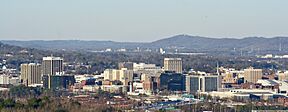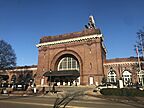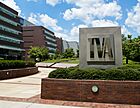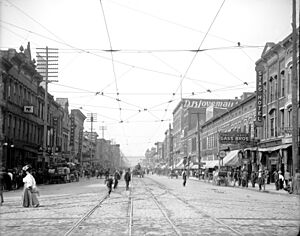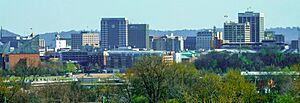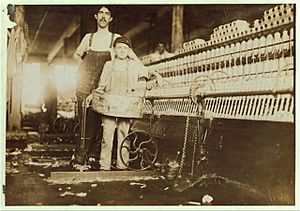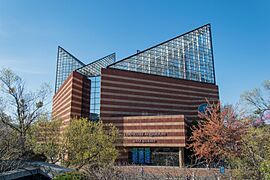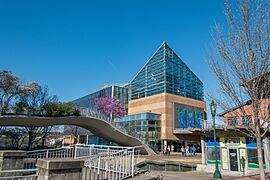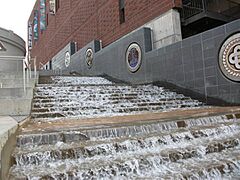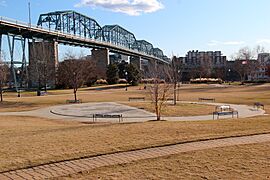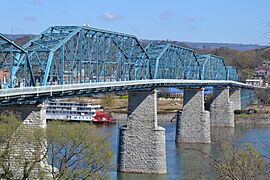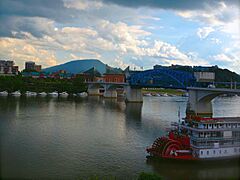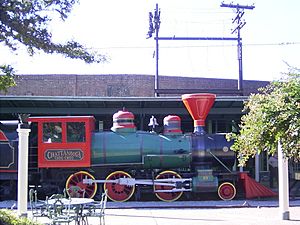Chattanooga, Tennessee facts for kids
Quick facts for kids
Chattanooga
|
|||||
|---|---|---|---|---|---|
|
|
|||||
|
|||||
| Nicknames:
Scenic City (official); Chatt, Chattown, Gig City, Nooga, and River City
|
|||||
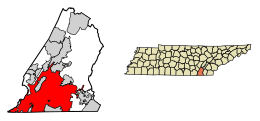
Location of Chattanooga in Hamilton County, Tennessee
|
|||||
| Country | United States | ||||
| State | Tennessee | ||||
| County | Hamilton | ||||
| Incorporated | 1839 | ||||
| Government | |||||
| • Type | Mayor-council | ||||
| Area | |||||
| • City | 150.08 sq mi (388.70 km2) | ||||
| • Land | 142.35 sq mi (368.69 km2) | ||||
| • Water | 7.73 sq mi (20.01 km2) | ||||
| Elevation | 676 ft (206 m) | ||||
| Population
(2020)
|
|||||
| • City | 181,099 | ||||
| • Rank | 142nd in the United States 4th in Tennessee |
||||
| • Density | 1,272.19/sq mi (491.20/km2) | ||||
| • Urban | 398,569 (US: 105th) | ||||
| • Urban density | 1,366.4/sq mi (527.6/km2) | ||||
| • Metro | 562,647 (US: 101st) | ||||
| Demonym(s) | Chattanoogan | ||||
| Time zone | UTC−5 (EST) | ||||
| • Summer (DST) | UTC−4 (EDT) | ||||
| ZIP code(s) |
37401-37412, 37414-37416, 37419, 37421-37422, 37424, 37450
|
||||
| Area code(s) | 423 | ||||
| FIPS code | 47-14000 | ||||
| GNIS feature ID | 1307240 | ||||
| Airport | Chattanooga Metropolitan Airport | ||||
| Public transportation | CARTA | ||||
| Waterways | Tennessee River | ||||
Chattanooga (/ˌtʃætəˈnuːɡə/ CHAT-ə-NOO-gə) is a city in Tennessee, United States. It is located along the Tennessee River and borders Georgia to the south. In 2020, Chattanooga had a population of 181,099. This makes it Tennessee's fourth-largest city. It is also one of the two main cities in East Tennessee, along with Knoxville.
Chattanooga was a very important city during the American Civil War. This was because many railroads met there. After the war, these railroads helped the city grow into a major industrial center in the Southeastern United States. Today, Chattanooga's economy includes car manufacturing, advanced factories, food and drink production, healthcare, and tourism. The city is still a key transportation hub. It has many Interstate highways and railroad lines.
The Tennessee River divides Chattanooga. The city sits between the ridge-and-valley Appalachians and the Cumberland Plateau. Both are parts of the larger Appalachian Mountains. Chattanooga's official nickname is the "Scenic City." This name comes from the beautiful mountains, ridges, and valleys around it. Other nicknames include "River City," "Chatt," "Nooga," "Chattown," and "Gig City." "Gig City" refers to its very fast internet service.
Chattanooga is famous worldwide because of the 1941 song "Chattanooga Choo Choo" by Glenn Miller and his orchestra. The city is also home to the University of Tennessee at Chattanooga (UTC) and Chattanooga State Community College.
Contents
History of Chattanooga
Early Times in Chattanooga
The first people to live in the Chattanooga area were Native Americans. There is evidence of people living here as far back as 10,000 BCE. They lived here continuously through different periods. These groups included the Mississippian and Cherokee peoples. The Chickamauga Mound is the oldest visible artwork in Chattanooga. It dates back to around 750 CE.
The name "Chattanooga" comes from a Native American word. It means "rock" or "rock rising to a point." This might refer to Lookout Mountain. In 1776, Dragging Canoe and his Cherokee group settled here. They wanted to resist European settlers. Later, in 1816, John Ross started Ross's Landing. This place became a center for the Cherokee Nation.
In 1838, the U.S. government forced the Cherokees to move west. This difficult journey is known as the "Trail of Tears." Many Native Americans died along the way. Ross's Landing was one of the main camps where they were held before their forced journey. In 1839, Ross's Landing officially became the city of Chattanooga. The city grew quickly because of its location for river trade. When the railroad arrived in 1850, Chattanooga became a very busy town.
Chattanooga During the Civil War
Chattanooga was a key city during the American Civil War. It was a central point for railroads. These railroads helped the Confederacy move supplies. Union forces took control of Chattanooga in September 1863. After the Battle of Chickamauga, the Union Army retreated to the city.
In November 1863, the Battles for Chattanooga began. Union forces, led by Ulysses S. Grant, attacked Confederate troops. They fought battles at Orchard Knob, Lookout Mountain, and Missionary Ridge. The Union Army won these battles. These victories were very important for the Union. They helped turn the war in their favor. After the war, Chattanooga became a major railroad and industrial center.
The Great Flood of 1867
The biggest flood in Chattanooga's history happened in 1867. The water rose very high and covered the city. This was before the Tennessee Valley Authority (TVA) was created in 1933. The TVA built a system of dams to control floods. Because of the TVA, floods in Chattanooga are now much smaller. The city was a top priority when the TVA system was designed.
Chattanooga in the 20th Century
Chattanooga grew during World War I. By the 1930s, it was known as the "Dynamo of Dixie." This nickname inspired the famous 1941 song "Chattanooga Choo Choo." In the 1960s, Chattanooga was the first city in Tennessee to have a complete interstate highway system.
However, the mountains around Chattanooga also trapped pollution. In 1969, the government said Chattanooga had the dirtiest air in the nation. The city also faced challenges like job losses and social issues. In the mid-1980s, local leaders started "Vision 2000." This plan aimed to improve and renew Chattanooga. The city's population grew again in the 1990s.
The Civil Rights Movement in Chattanooga
The Civil Rights Movement in Chattanooga began in 1960. High school students organized peaceful sit-in protests. They sat at businesses downtown to protest segregation. Some people reacted with anger and violence. The mayor even used water hoses against the protesters. But three months later, the city agreed to desegregate downtown businesses.
When Martin Luther King Jr. was assassinated, Chattanooga avoided riots. City leaders met with young people to calm the situation. They listened to their complaints about unfairness. This helped prevent widespread unrest. In 1971, John Franklin Sr. became the first African-American elected official in Chattanooga.
In 1980, a serious incident occurred. Three members of the Ku Klux Klan shot five Black women. The women survived. An all-white jury later found the Klan members not guilty. This led to several nights of protests in Chattanooga. The five women then sued the Klan in federal court. In 1982, the court ordered the Klan to pay the women a large sum of money. This case helped create a legal way to challenge the Klan across the country.
In 1987, the city's voting system was challenged. It was argued that the system made it harder for Black voters to have their voices heard. As a result, the city changed its voting system.
Chattanooga in the 21st Century
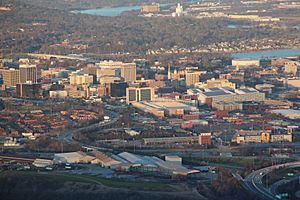
Since 2000, Chattanooga has continued to grow. Many people from other states and countries have moved there. In 2010, Chattanooga launched the first one-gigabit-per-second internet service in the U.S. This super-fast internet is provided by the city's own utility company, EPB.
In 2012, Chattanooga created its own special typeface called Chatype. This was the first time a city in the U.S. had its own typeface. It was also the first custom-made typeface funded by many people.
Exploring Chattanooga's Geography
Chattanooga covers about 142 square miles of land. The most important natural features are the Tennessee River and the mountains around it. The Chickamauga Dam holds back the Tennessee River north of downtown. The city is located between the Ridge-and-valley Appalachians and the Cumberland Plateau. The river separates these mountain areas. Downtown Chattanooga is about 676 feet above sea level.
Cityscape and Downtown Attractions
Downtown Chattanooga offers many fun things to do. You can find entertainment, restaurants, and cultural sites. Popular spots include the Tennessee Aquarium, which opened in 1992. The Creative Discovery Museum is a hands-on museum for kids. The historic Walnut Street Bridge is also a favorite. It reopened in 1993 for pedestrians.
The downtown area has several important buildings. These include the Republic Centre, the tallest building in Chattanooga. The Read House Hotel is the oldest continuously operating hotel in the Southeastern U.S. The Chattanooga Choo-Choo Hotel is a former train station. The Tivoli Theatre is another historic landmark.
Chattanooga's downtown has four main bridges over the Tennessee River. These are the Walnut Street Bridge, the Market Street Bridge, the Olgiati Bridge, and the Veterans Memorial Bridge. These bridges connect different parts of the city. They also link to the Tennessee Riverwalk and the Bluff View Art District. Downtown parks include Coolidge Park and Renaissance Park. The Martin Luther King District has a very large mural. It was created by several artists.
Downtown Improvements and Awards
In recent years, a lot of money has been spent to improve Chattanooga. The "21st Century Waterfront Plan" was a big project. It redeveloped the waterfront area and finished in 2005. The Tennessee Aquarium has been a major draw. Since it opened, downtown Chattanooga has received over $5 billion in private investments.
The city has won awards for being a great place to live. Forbes magazine even ranked Chattanooga as one of the best "Bang For Your Buck" cities. This means it offers good value for living costs.
Neighborhoods of Chattanooga
Chattanooga has many interesting neighborhoods. Several are listed on the National Register of Historic Places. These include Ferger Place, Fort Wood, and St. Elmo. The city also manages local historic districts like Battery Place and Missionary Ridge.
- East Brainerd
- Ferger Place
- Fort Wood
- Highland Park
- Lupton City
- Missionary Ridge
- St. Elmo
- Lookout Valley
- Tyner
Chattanooga's Climate
Chattanooga has a humid subtropical climate. This means it has four distinct seasons. Winters are usually mild, but it can get very cold sometimes. Snowfall varies each year. Summers are hot and humid. Temperatures often reach 90°F (32°C) or higher. Chattanooga is one of the fastest-warming cities in the U.S. due to climate change.
The city gets over 52 inches (132 cm) of rain each year. It rains more from November to March. This is because warm, moist air from the Gulf of Mexico meets cold, dry air from Canada. Even with the mountains, tornadoes can affect Chattanooga. For example, an EF3 tornado hit parts of the city in April 2020. It caused damage and three deaths.
| Climate data for Chattanooga Metropolitan Airport, Tennessee (1991–2020 normals, extremes 1879–present) | |||||||||||||
|---|---|---|---|---|---|---|---|---|---|---|---|---|---|
| Month | Jan | Feb | Mar | Apr | May | Jun | Jul | Aug | Sep | Oct | Nov | Dec | Year |
| Record high °F (°C) | 78 (26) |
82 (28) |
89 (32) |
93 (34) |
99 (37) |
107 (42) |
107 (42) |
105 (41) |
104 (40) |
100 (38) |
86 (30) |
78 (26) |
107 (42) |
| Mean maximum °F (°C) | 68.8 (20.4) |
73.0 (22.8) |
80.6 (27.0) |
86.0 (30.0) |
90.5 (32.5) |
95.2 (35.1) |
97.1 (36.2) |
96.4 (35.8) |
93.5 (34.2) |
85.8 (29.9) |
76.8 (24.9) |
69.3 (20.7) |
98.3 (36.8) |
| Mean daily maximum °F (°C) | 51.0 (10.6) |
55.6 (13.1) |
64.1 (17.8) |
73.6 (23.1) |
81.0 (27.2) |
87.6 (30.9) |
90.5 (32.5) |
89.8 (32.1) |
84.3 (29.1) |
74.1 (23.4) |
62.0 (16.7) |
53.2 (11.8) |
72.2 (22.3) |
| Daily mean °F (°C) | 41.7 (5.4) |
45.6 (7.6) |
53.2 (11.8) |
61.7 (16.5) |
70.0 (21.1) |
77.4 (25.2) |
80.7 (27.1) |
80.0 (26.7) |
73.9 (23.3) |
62.7 (17.1) |
51.2 (10.7) |
44.3 (6.8) |
61.9 (16.6) |
| Mean daily minimum °F (°C) | 32.4 (0.2) |
35.6 (2.0) |
42.2 (5.7) |
49.9 (9.9) |
59.0 (15.0) |
67.3 (19.6) |
71.0 (21.7) |
70.2 (21.2) |
63.6 (17.6) |
51.4 (10.8) |
40.3 (4.6) |
35.3 (1.8) |
51.5 (10.8) |
| Mean minimum °F (°C) | 14.9 (−9.5) |
19.6 (−6.9) |
25.5 (−3.6) |
34.3 (1.3) |
44.1 (6.7) |
56.9 (13.8) |
63.4 (17.4) |
61.9 (16.6) |
50.3 (10.2) |
35.1 (1.7) |
25.9 (−3.4) |
20.8 (−6.2) |
12.9 (−10.6) |
| Record low °F (°C) | −10 (−23) |
−10 (−23) |
2 (−17) |
25 (−4) |
34 (1) |
39 (4) |
51 (11) |
50 (10) |
36 (2) |
22 (−6) |
4 (−16) |
−2 (−19) |
−10 (−23) |
| Average precipitation inches (mm) | 5.02 (128) |
5.03 (128) |
5.34 (136) |
4.87 (124) |
3.94 (100) |
4.18 (106) |
5.08 (129) |
3.67 (93) |
4.23 (107) |
3.59 (91) |
4.80 (122) |
5.25 (133) |
55.00 (1,397) |
| Average snowfall inches (cm) | 1.0 (2.5) |
1.2 (3.0) |
1.1 (2.8) |
0.0 (0.0) |
0.0 (0.0) |
0.0 (0.0) |
0.0 (0.0) |
0.0 (0.0) |
0.0 (0.0) |
0.0 (0.0) |
0.0 (0.0) |
0.3 (0.76) |
3.6 (9.1) |
| Average precipitation days (≥ 0.01 in) | 10.6 | 11.1 | 11.4 | 10.1 | 10.6 | 11.4 | 11.9 | 9.4 | 7.9 | 7.9 | 9.1 | 11.3 | 122.7 |
| Average snowy days (≥ 0.1 in) | 0.7 | 1.1 | 0.3 | 0.0 | 0.0 | 0.0 | 0.0 | 0.0 | 0.0 | 0.0 | 0.0 | 0.3 | 2.4 |
| Average relative humidity (%) | 71.2 | 68.2 | 65.9 | 63.8 | 71.5 | 73.1 | 74.9 | 76.0 | 77.0 | 74.6 | 73.5 | 72.9 | 71.9 |
| Mean monthly sunshine hours | 147.0 | 155.6 | 200.5 | 240.2 | 275.6 | 275.5 | 265.2 | 256.8 | 227.9 | 218.8 | 158.7 | 140.4 | 2,562.2 |
| Percent possible sunshine | 47 | 51 | 54 | 61 | 64 | 63 | 60 | 62 | 61 | 63 | 51 | 46 | 58 |
| Source: NOAA (relative humidity and sun 1961–1990) | |||||||||||||
Time Zone Information
Chattanooga is in the Eastern Time Zone. Counties to its west, in both Tennessee and Alabama, use the Central Time Zone.
People and Population
| Historical population | |||
|---|---|---|---|
| Census | Pop. | %± | |
| 1870 | 6,093 | — | |
| 1880 | 12,892 | 111.6% | |
| 1890 | 29,100 | 125.7% | |
| 1900 | 30,154 | 3.6% | |
| 1910 | 44,604 | 47.9% | |
| 1920 | 57,895 | 29.8% | |
| 1930 | 119,798 | 106.9% | |
| 1940 | 128,613 | 7.4% | |
| 1950 | 131,041 | 1.9% | |
| 1960 | 130,009 | −0.8% | |
| 1970 | 119,923 | −7.8% | |
| 1980 | 169,514 | 41.4% | |
| 1990 | 152,466 | −10.1% | |
| 2000 | 155,554 | 2.0% | |
| 2010 | 167,674 | 7.8% | |
| 2020 | 181,099 | 8.0% | |
| 2023 (est.) | 187,030 | 11.5% | |
| Sources: | |||
Chattanooga's population has changed over the years. In 2020, there were 181,099 people living in the city. The city is home to many different groups of people. About 54.65% of the population was White. About 28.93% was Black or African American. Asian people made up about 2.74%. People of Hispanic or Latino origin made up about 9.16% of the population.
The average age in Chattanooga in 2010 was 38.1 years old. About 21.3% of the population was under 18. About 14.7% was 65 or older. The city's larger metropolitan area has also grown. It includes Hamilton, Marion, and Sequatchie counties in Tennessee. It also includes Catoosa, Dade, and Walker counties in Georgia.
Religious Life in Chattanooga
The largest religious group in Chattanooga is Christianity. Many different Christian churches are present. The Southern Baptist Convention is the largest Christian group. Other large groups include the United Methodist Church and non-denominational churches. The Roman Catholic Diocese of Knoxville also has a presence. Islam also has followers in Chattanooga.
Chattanooga's Economy
Chattanooga has a diverse and growing economy. It includes both manufacturing and service industries. Many well-known businesses are based in Chattanooga. These include BlueCross BlueShield of Tennessee and The Chattanooga Bakery, which makes Little Debbie snack cakes. The world's first Coca-Cola bottling plant was also in Chattanooga.
Large companies like Amazon.com, BASF, and DuPont have factories or distribution centers here. The William Wrigley Jr. Company makes Altoids breath mints only in Chattanooga.
A major event for Chattanooga's economy was Volkswagen building a car plant here. The Volkswagen Chattanooga Assembly Plant opened in 2011. It cost $1 billion to build. The plant makes the Volkswagen Passat and Atlas models. It also has a research center. This plant created thousands of jobs. In 2019, Volkswagen announced plans to expand the plant to build electric vehicles. This expansion will create more jobs and investment.
Tourism is also a growing part of Chattanooga's economy. In 2014, tourism brought in over $1 billion in revenue for Hamilton County. The city also supports new businesses and startups. This is partly thanks to EPB's fiber optic internet network.
City Utilities and Services
Most of Chattanooga's electricity comes from the city-run Electric Power Board. EPB also provides high-speed internet, TV, and phone service. They have the largest city-owned fiber optic system in the U.S. The TVA also provides electricity. They operate the Sequoyah Nuclear Power Plant and other facilities nearby.
Natural gas is provided by the Chattanooga Gas Company. Water is provided by the Tennessee-American Water Company.
EPB's Super-Fast Internet Network
In 2009, EPB began building its fiber optic network. By 2010, EPB was the first city-owned utility in the U.S. to offer internet speeds up to ten gigabits per second. This super-fast internet has helped Chattanooga's economy. It helped attract companies like Volkswagen and Amazon. Other cities have studied Chattanooga's network. However, state laws in Tennessee have limited its expansion to nearby communities.
The fiber optic network also helps the city's electrical system. It helps detect problems early and saves energy. This shows that the investment in the network is very useful.
Banking in Chattanooga
Chattanooga has many banks. In 2014, there were 27 banks in the metropolitan area. This shows the city's strong financial health. Large regional banks like First Horizon Bank and Truist Financial are here. There are also offices for major banks like UBS, Chase, and Bank of America.
In 2015, several local banks were bought by other banks. This left only one Chattanooga-based independent bank, First Volunteer Bank.
Culture and Things to Do
Fun Attractions in Chattanooga
Chattanooga has many exciting attractions. These include the Tennessee Aquarium, caves, and new waterfront areas along the Tennessee River. In downtown, you can visit the Chattanooga Choo Choo Hotel. It is in a renovated old train station. The Creative Discovery Museum is a hands-on museum for kids. There is also an IMAX 3D Theatre and the Hunter Museum of American Art. The Tennessee Riverwalk is a 13-mile trail along the river. It's great for walking and biking.
Across the river is the North Shore district. This area has unique local shops and restaurants. It also has parks like Coolidge Park and Renaissance Park. The Chattanooga Zoo at Warner Park is home to many animals. It has grown a lot since it started in 1937.
Nearby, you can visit Rock City on Lookout Mountain. You might have seen "See Rock City" painted on barns! The mountain also has Ruby Falls and Craven's House. The Lookout Mountain Incline Railway is a very steep train ride. It takes you to the top of the mountain. From there, you can see amazing views of Chattanooga.
Other nearby places for outdoor fun include Raccoon Mountain Reservoir and Raccoon Mountain Caverns. The Ocoee River is famous for rafting and kayaking. Harrison Bay State Park is great for fishing and camping. Just outside Chattanooga is the Lake Winnepesaukah amusement park.
Museums to Visit
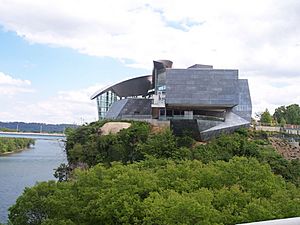
Chattanooga is the birthplace of the tow truck. So, it's home to the International Towing and Recovery Hall of Fame and Museum. If you like trains, visit the Tennessee Valley Railroad Museum (TVRM). It's the largest operating historic railroad in the South.
Other interesting museums include the National Medal of Honor Heritage Center. The Creative Discovery Museum is great for kids. The Hunter Museum of American Art has many artworks. The Institute of Contemporary Arts Chattanooga (ICA Chattanooga) shows modern art.
Performing Arts in Chattanooga
Chattanooga has many places for performing arts. The historic Tivoli Theatre opened in 1921. It is home to the Chattanooga Symphony and Opera (CSO). The CSO was the first combined symphony and opera company in the U.S. The Chattanooga Theatre Centre puts on many plays each year. The Soldiers and Sailors Memorial Auditorium is another popular place for performances.
Festivals and Events
Chattanooga hosts many fun festivals. The Riverbend Festival is a big music festival every June. The "Bessie Smith Strut" celebrates blues and jazz music. The "Southern Brewer's Festival" and "River Roast" celebrate beer and barbecue.
The Moon River Festival is a three-day music festival in September. It moved to Chattanooga in 2018. Both Moon River and Riverbend are ranked among the top music festivals in the South. "Nightfall" is a free weekly concert series in Miller Plaza. It features different types of music from May to September. The Chattanooga Market has events all year, including an Oktoberfest.
The Chattanooga Dulcimer Festival is held every June. It features workshops and performances. Chattanooga is also a center for bluegrass music. The 3 Sisters Festival showcases bluegrass artists.
Every January, Chattanooga hosts Chattacon. This is a science fiction and fantasy convention. It brings together many fans. Since 2014, the city has also hosted the Chattanooga Film Festival.
Sports in Chattanooga
Chattanooga has a growing and diverse sports scene. It includes professional soccer, college sports, and minor league baseball. The city also hosts major events like the Ironman Triathlon.
Organized Sports Teams
College Sports
The University of Tennessee at Chattanooga (UTC) Mocs compete in NCAA Division I. Their teams play football, basketball, soccer, volleyball, and more. Finley Stadium in Chattanooga used to host the NCAA Division I Football Championship game.
Baseball Teams
The Chattanooga Lookouts are a minor league baseball team. They are part of the Cincinnati Reds organization. They play at AT&T Field downtown. Chattanooga also has semi-professional football teams.
Professional Soccer Teams
Chattanooga has two professional soccer teams. Chattanooga FC started in 2009. They have been very successful and have drawn large crowds. In 2019, Chattanooga FC became one of the first U.S. sports teams to sell supporter shares. This means fans can own a part of the team. The Chattanooga Red Wolves SC is another professional soccer team. They play in USL League One. They are building a new soccer stadium in East Ridge.
Rugby Teams
Chattanooga is also home to several rugby teams. These include the Chattanooga Rugby Football Club. They have men's and women's teams. There are also college teams at UTC and a high school team. All home games are played at Montague Park.
Outdoor Sports and Activities
Rowing The Head of the Hooch is a large rowing event. It takes place on the Tennessee River in downtown Chattanooga every November. It's the second-largest rowing competition in the U.S. Many college and youth teams compete here.
Cycling Chattanooga has hosted the Volkswagen USA Cycling Professional Road & Time Trial National Championships. Cyclists race through downtown and up Lookout Mountain. The city also has the Chattanooga Bicycle Club. This club promotes safe cycling for transportation and fun.
Running Chattanooga is a great place for outdoor sports. It has been named "Best Town Ever" by Outside Magazine twice. People enjoy hunting, fishing, trail running, and rock climbing. The internationally known StumpJump 50k trail race is held nearby. The Erlanger Half Marathon and Marathon are popular spring running events.
Triathlons Chattanooga hosts the Ironman Triathlon. This is a very tough competition. It includes a 2.4-mile swim, a 112-mile bike ride, and a 26.2-mile run. The city also hosts the Ironman 70.3 event, which is a shorter version. In 2015, Chattanooga was chosen to host the 2017 Ironman 70.3 World Championships.
Chattanooga is a "Bronze level" city for biking. This means it's recognized for being bike-friendly. The city also has Outdoor Chattanooga. This group promotes outdoor activities like biking and paddling. The Tennessee River Blueway is a 50-mile section of the Tennessee River. It's great for paddling.
Media and Communication
Chattanooga has many local and national media outlets. They reach about one million people in four states.
Newspapers in Chattanooga
The Chattanooga Times Free Press is the city's only daily newspaper. It was formed in 1999 when two rival papers merged. It is unique because it has two editorial pages. One page is more liberal, and the other is more conservative.
The Chattanooga Pulse is a free weekly newspaper. It focuses on arts, music, and culture. Enigma is a free monthly magazine about pop culture. The Chattanooga News Chronicle is an African-American weekly newspaper.
Online News Sources
The Chattanoogan is an online news source. It covers news from Chattanooga and the surrounding areas. Nooga.com was relaunched as NOOGAtoday in 2018. It provides daily news focusing on local business, politics, and entertainment.
Radio Stations
Chattanooga has many AM and FM radio stations. They play different types of music and talk shows. Some stations are operated by local universities.
AM Radio Stations
- WDYN 980 AM – Southern Gospel
- WFLI 1070 AM – Oldies from the '60s & '70s
- WGOW 1150 AM – News Talk
- WNOO 1260 AM – Urban Gospel and Motown
- WXCT 1370 AM – Alternative
- WLMR 1450 AM – Christian Talk
- WJOC 1490 AM – Southern Gospel
FM Radio Stations
- WUTC 88.1 FM – NPR/Mixed music
- WMBW 88.9 FM – Christian
- WSMC 90.5 FM – Classical/NPR
- WDEF-FM 92.3 FM – Adult Contemporary
- WMPZ 93.5 FM – Urban Adult Contemporary
- WJTT 94.3 FM – Urban Contemporary
- WALV-FM 95.3 FM – Christian
- WDOD 96.5 FM – Top-40
- WUUQ 97.3 FM / W257AZ 99.3 FM – Classic Country
- WLND 98.1 FM – Hot AC
- WUSY 100.7 FM – Contemporary Country
- WGOW 102.3 FM – Talk Radio
- WKXJ 103.7 FM – Top 40
- WRXR-FM 105.5 FM – Active Rock
- WSKZ 106.5 FM – Classic Rock
- WOGT 107.9 FM – Country
Television Stations
Chattanooga's television stations include:
- WRCB channel 3, NBC
- WTVC channel 9, ABC/Fox
- WDEF channel 12, CBS
- WTCI channel 45, PBS
- WFLI-TV channel 53, The CW/MyNetworkTV
Education in Chattanooga
Schools for Kids and Teens
Most schools in Chattanooga are public schools. They are part of the Hamilton County Schools system. The Howard School was the first public school in the area. It opened in 1865 after the Civil War. There are also special public magnet schools. These include the Chattanooga School for the Arts and Sciences and the STEM School Of Chattanooga.
Chattanooga also has several well-known private schools. These include Baylor School, Chattanooga Christian School, and McCallie School. The Siskin Children's Institute helps young children with special education needs.
Colleges and Universities
Chattanooga has many options for higher education. The University of Tennessee at Chattanooga (UTC) is a large university. It has over 11,587 students. Chattanooga State Community College is a two-year college. It has about 8,150 students.
The University of Tennessee College of Medicine has a branch in Chattanooga. It trains medical students and doctors. Covenant College is a private college located nearby on Lookout Mountain. Southern Adventist University is in Collegedale, Tennessee.
Public Library System
The Chattanooga Public Library first opened in 1905. It has been serving the city for over a century. The main library is located at the corner of Tenth and Broad streets.
Transportation in Chattanooga
Chattanooga is an important transportation hub. It has a complex system of highways, roads, tunnels, and railroad lines. It also has a commercial airport. The city can get very busy with truck traffic. This is because many trucks pass through Chattanooga on their way to other places.
Highways Connecting Chattanooga
Interstate 75 (I-75) connects Chattanooga to Knoxville and Atlanta. Interstate 24 (I-24) goes through the city and connects to Nashville. Interstate 59 (I-59) starts southwest of Chattanooga and goes to Birmingham.
U.S. Route 27 (US 27) is a major highway that runs through the city. It connects Chattanooga to northern areas like Red Bank and Soddy Daisy. Other U.S. Highways also pass through Chattanooga. These include US 11, US 41, US 64, US 72, US 76, and US 127.
Tunnels in the City
Chattanooga has several tunnels that help traffic flow.
- Bachman Tubes: These carry Ringgold Road into East Ridge.
- Missionary Ridge Tunnels: These carry McCallie and Bailey Avenues through Missionary Ridge.
- Stringer's Ridge Tunnel: This carries Cherokee Boulevard through Stringer's Ridge.
- Wilcox Tunnel: This carries Wilcox Boulevard through Missionary Ridge.
Public Transportation Options
The city has a public bus company called the Chattanooga Area Regional Transportation Authority (CARTA). CARTA has 17 bus routes. It also offers a free electric shuttle service downtown. Some buses even have free Wi-Fi.
Chattanooga also has a bicycle transit system called Bike Chattanooga. It has 300 bikes and many docking stations. This makes it easy to rent a bike and explore the city.
Railroad Connections
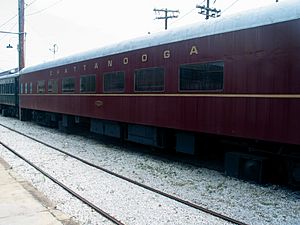
Chattanooga is well-known for its railroad history, thanks to the song "Chattanooga Choo Choo". Today, it is a major hub for freight trains. Norfolk Southern (NS) and CSX operate many trains here. The Tennessee Valley Railroad Museum (TVRM) also provides historic train rides.
Even though there's a lot of freight train activity, there is no passenger train service for people to travel long distances. However, there are plans for a future Amtrak route that would connect Atlanta to Nashville, with a stop in Chattanooga.
The Lookout Mountain Incline Railway is a popular tourist attraction. It's a very steep train ride that goes up Lookout Mountain. Some local residents also use it to get up and down the mountain, especially in bad weather.
Bridges Over the Tennessee River
The Tennessee River divides Chattanooga. There are seven bridges that cross the river. Five are for cars, one is for trains, and one is for pedestrians.
- P.R. Olgiati Bridge: This bridge carries U.S. Highway 27 north from downtown.
- Market Street Bridge: Also known as the John Ross Bridge, this is a draw bridge. It was built in 1917 and was renovated in 2007.
- Walnut Street Bridge: Known as "The Walking Bridge," it's one of the longest pedestrian bridges in the nation. It was built in 1891 and became a pedestrian-only bridge in 1993.
- Veterans Memorial Bridge: This bridge helps people from Hixson and other northern areas get downtown quickly.
- C.B. Robinson Bridge: This bridge carries DuPont Parkway.
- Tenbridge: This is a train bridge that crosses the river. It was built in 1920.
- Wilkes T. Thrasher Bridge: This bridge carries Highway 153 over the Chickamauga Dam.
Air Travel
The Chattanooga Metropolitan Airport (CHA) offers flights to many U.S. cities. Several airlines operate here, including Allegiant Airlines, American Eagle, Delta Air Lines, and United Express.
Sister Cities of Chattanooga
Chattanooga has "sister city" relationships with several cities around the world. These partnerships help promote cultural exchange and understanding.
 Hamm, Germany (1975)
Hamm, Germany (1975) Wuxi, China (1982)
Wuxi, China (1982) Givatayim, Israel (1988)
Givatayim, Israel (1988) Nizhny Tagil, Russia (1996)
Nizhny Tagil, Russia (1996) Gangneung, South Korea (2003)
Gangneung, South Korea (2003) Wolfsburg, Germany (2011)
Wolfsburg, Germany (2011) Tōno, Japan (2017)
Tōno, Japan (2017) Accra, Ghana (2024)
Accra, Ghana (2024)
In 2007, trees native to each sister city were planted at Coolidge Park's Peace Grove. This grove celebrates these international friendships.
Friendship Cities
Chattanooga also has friendly relations with:
Images for kids
-
The Chickamauga Lock and Dam on the Tennessee River.
See also
 In Spanish: Chattanooga (Tennessee) para niños
In Spanish: Chattanooga (Tennessee) para niños


